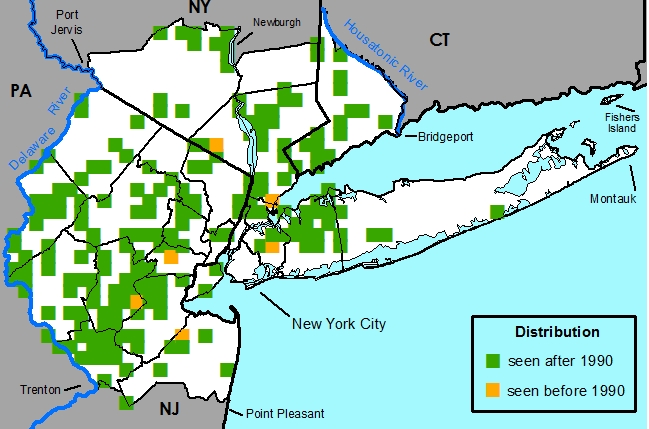Lonicera maackii (Rupr.) Herder - Amur Honeysuckle,Maack's Honey
Non-native , Frequent
By Steven D. Glenn
Not peer reviewed
Last Modified 02/15/2013

Common Names
Amur Honeysuckle,Maack's HoneyField Identification
Semi-evergreen shrub with simple, opposite, entire leaves; with light yellow or white (often tinged with rose-pink or purple) tubular flowers followed by red berries.Other uses
Used as an ornamental in landscaping situations and is hardy to USDA zones 2?-3.
Poisonous properties
Although the berries of some species are known to be edible; generally, ingestion of the fruit causes mild to moderate nausea, vomiting, and diarrhea; death is unlikely.
Stories
(Luken, 1997) (Luken & Thieret, 1995)
The first specimens were collected near the Amur River in 1855 by the Russian plant explorer Richard Maack. Propagules were introduced into northeastern North America in 1896-1898. Although the first record of Amur honeysuckle's potential escape from cultivation occurred near Chicago in the mid 1920's; evidence of naturalized populations in northeastern North America began to appear in the late 1950's.
Nomenclature
Lonicera maacki Herd. Bull. Soc. Nat. Mosc. 37, 204. 1864.Xylosteum maackii Rupr., Bull. Phys.-Math. Acad. Sci. St. Petersb. 15: 369. 1857.
Lonicera maackii (Rupr.) Maxim., Mem. Div. Sav. Acad. Sci. St. Petersb. 9: 136. 1859.
Caprifolium maackii Kuntze, Rev. Gen. Pl. 1: 274. 1891.
TYPE: unknown
Description
HABIT Perennial, deciduous (semi-evergreen), phanerophytic, shrub, monoclinous, 1-5 m tall. Upright vase growth habit in youth, becoming arching vase and spreading with age.STEMS Main stems ascending or erect, round. Bark furrowed or fibrous, exfoliating or not exfoliating, gray-brown. Branches ascending or horizontal to arching. Twigs gray to brown, not odoriferous, terete, 1-5 mm in diam., smooth, with short and unbranched hairs or with long and unbranched hairs, erect or appressed or spreading, white, sparse or dense, distributed apically, not glabrescent, eglandular. Pith absent. Sap translucent. For a detailed analysis of the root anatomy see Gasson, 1979. For a study of the xylem see Chiu, 1992.
BUDS Terminal and axillary present, monomorphic, scattered along stem; terminal bud ovoid, pointed; axillary buds 1-2 per axil, ovoid, pointed. Bud scales light brown, imbricate, with long and unbranched gray hairs, appressed, dense, distrubted throughout, eglandular. Bud scale scars not encircling the stem. Leaf scars thinly crescent- shaped. Vascular bundle scars 3.
LEAVES Opposite, simple, spiral, 2 per node, spaced somewhat evenly along stem, divergent from stem. Stipules absent. Leaves petiolate, petiole flattened, 0.5-1 cm long, with long and unbranched hairs, erect or spreading, moderately dense or dense, distributed throughout, not glabrescent, eglandular. Leaf blades: abaxial surface light green, adaxial surface green, ovate, bilaterally symmetric, 3-10 cm long, 2-5 cm wide, base cuneate or obtuse, margin entire, apex acuminate, abaxial surface with long and unbranched white hairs, erect or spreading, sparse or moderately dense, distributed along midveins, not glabrescent, eglandular. Adaxial surface with long and unbranched white hairs, erect or spreading, sparse, distributed along midveins or distributed marginally, not glabrescent, eglandular. Leaves usually remain on plant and green until late November.
INFLORESCENCES Bisexual, axillary 2-flowered cyme. Peduncle 0.2-0.25 cm long, with long, unbranched hairs and orange-red glands. Rachis absent, flowers sessile at apex of peduncle. Bracts sessile, light greenish yellow or light green, linear triangular, 3.5-5 mm long, 0.5-1 mm wide, with long and unbranched hairs, orange-red glands present. Bracteoles 2, light green, 2 mm long, 1 mm wide, margin entire, apex obtuse, with long and unbranched hairs, glands present.
FLOWERS Serotinous, formed on last season's growth, bisexual, with sepals and petals readily distinguishable from one another, 5-merous, 2 flowers per inflorescence, fragrant. Calyx actinomorphic, of fused sepals, deciduous, abaxial and adaxial surfaces light yellowish green (often tinged with rose-pink or purple). Sepal lobes 5, triangular, margin entire, apex acute, with long and unbranched white hairs, erect or spreading, moderately dense, distributed throughout, glands present. Corolla zygomorphic, of fused petals, deciduous, abaxial and adaxial surfaces light yellow or white (often tinged with rose-pink or purple), 15-20 mm long, scattered glands on exterior. Petal lobes 5. Margin entire, apex obtuse, abaxial surface glabrous or with long and unbranched hairs, glands present, adaxial surface glabrous, eglandular. Gynoecium syncarpous. Locules 2-3. Stigmas 1, capitate. Styles 1, hairy. Ovary inferior. Placentation axile. Androecium epipetalous, exserted, haplostemous, inserted near the top of the corolla tube. Stamens 5. Anthers opening along the long axis, yellow, glabrous, eglandular. Filaments straight, light yellow, with long and unbranched hairs.
FRUITS Bacca, red, globose, 7-8 mm in diameter, glabrous, eglandular. For a review of infructescence development and morphology see Malinkina, 2002(In Russian).
SEEDS Seeds 2 to 7, light yellowish orange or light yellow, ovoid, 3-3.5 mm long, 2-2.5 mm wide, glabrous, eglandular.
Habitat
Found in moist to mesic forests, thickets, fields and roadsides.Distribution
Indigenous to northern China, Korea and Japan; becoming naturalized throughout eastern North America.United States -- AL?, AR, CT, DE, GA, IA, IL, IN, KS, KY, LA?, MA, MD, MI, MO, MS, NC, ND, NE, NJ, NY, OH, OK?, PA, SC, TN, TX, VA, WI, WV
Canada -- ON
Rarity Status
Global Heritage Rank -- G5Species Biology
Flowering
May [week 1] - June [week 1]
Pollination
(Deering, 1999) (Graenicher, 1900)
Flowers reported to be self incompatible. Probably: Mellitophily -- Andrena?, Apis?, Bombus?, Halictus?, Megachile?, Osmia?
Mycophily? -- Mesogramma?
Phalaenophily? -- Hemaris?
Ornithophily? -- Trochilus? (Hummingbird)
Fruiting
July [week 1] - November
Dispersal
Endozoochory -- avian frugivores: Turdus migratorius (Robin), Catharus minima (Gray-cheeked Trush), Catharus ustulatus (Swainson's Thrush), Dumetella carolinensis (Gray Catbird), Bombycilla cedorum (Cedar Waxwing), Cardinalis cardinalis (Cardinal), Carpodacus purpureus (Purple Finch), Carduelis tristis (Goldfinch), Zonotrichia albicollis (White-throated Sparrow), Mimus polyglottus (Mockingbird), Dendroica coronata?(Yellow-rumped Warbler), Toxosoma rufum? (Brown Thrasher), Cyanociita cristata? (Blue Jay)
Germination
Natural germination is believed to occur in the spring following autumn/winter dispersal. Germination is epigeous. This species sometimes exhibits embryo dormancy. Stratification in moist sand or peat at 32-50 degrees F for 60- 90 days is recommended. While definite information for the optimum storage of Lonicera seeds is lacking; generally, seed stored in a sealed container at 41 degrees F should remain viable for at least one year.